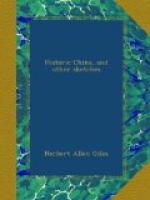sixteen small dishes or saucers which contain four
kinds of fresh fruits, four kinds of dried fruits,
four kinds of candied fruits, and four miscellaneous,
such as preserved eggs, slices of ham, a sort of sardine,
pickled cabbage, &c. These four are in the middle,
the other twelve being arranged alternately round
them. Wine is produced the first thing, and poured
into small porcelain cups by the giver of the feast
himself. It is polite to make a bow and place
one hand at the side of the cup while this operation
is being performed. The host then gives the signal
to drink and the cups are emptied instantaneously,
being often turned bottom upwards as a proof there
are no heel-taps. Many Chinamen, however, cannot
stand even a small quantity of wine; and it is no
uncommon thing when the feast is given at an eating-house,
to hire one of the theatrical singing-boys to perform
vicariously such heavy drinking as may be required
by custom or exacted by forfeit. The sixteen
small dishes above-mentioned remain on the table during
the whole dinner and may be eaten of promiscuously
between courses. Now we come to the dinner, which
may consist of eight large and eight small courses,
six large and six small, eight large and four small,
or six large and four small, according to the means
or fancy of the host, each bowl of food constituting
a course being placed in the middle of the table and
dipped into by the guests with chopsticks or spoon
as circumstances may require. The first is the
commonest, and we append a bill of fare of an ordinary
Chinese dinner on that scale, each course coming in
its proper place.
I. Sharks’ fins
with crab sauce.
1.
Pigeons’ eggs stewed with mushrooms.
2.
Sliced sea-slugs in chicken broth with ham.
II. Wild duck and Shantung
cabbage.
3.
Fried fish.
4.
Lumps of pork fat fried in rice flour.
III. Stewed lily roots.
5.
Chicken mashed to pulp, with ham.
6.
Stewed bamboo shoots.
IV. Stewed shell-fish.
7.
Fried slices of pheasant.
8.
Mushroom broth.
Remove—Two dishes
of fried pudding, one sweet and the other salt,
with
two dishes of steamed puddings, also one sweet and
one
salt.
[These four are put on the table together and with
them
is
served a cup of almond gruel.]
V. Sweetened duck.
VI. Strips of boned chicken
fried in oil.
VII. Boiled fish (of any kind)
with soy.
VIII. Lumps of parboiled mutton fried
in pork-fat.
These last four large courses are put on the table
one by one and are not taken away. Subsequently
a fifth, a bowl of soup, is added, and small basins
of rice are served round, over which some of the soup
is poured. The meal is then at an end. A
rince-bouche is handed to each guest and a
towel dipped in boiling water but well wrung out.
With the last he mops his face all over, and the effect




